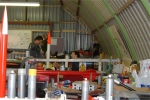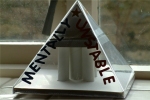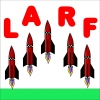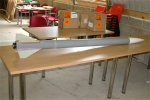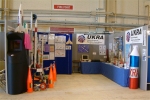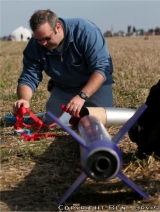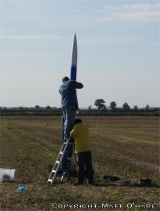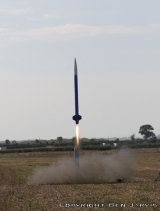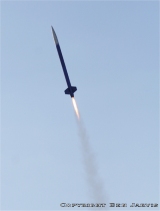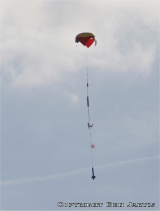How did I get in to rocketry? I started in the mid-80s when Estes products first became available in the UK. I built a couple of my own designs, and flew them successfully, then went off & got
interested in the usual adolescent interests, beer, girls, music, beer, girls, etc. so rocketry got put to one side & effectively forgotten about. Until one weekend in the late 90's when I had far too much time on my hands. I picked up an Estes starter
set in a local model shop, and roped in a mate to come & play. 2 rockets, half a dozen C6-5's and I was hooked. I'd forgotten the simple joy of pushing a BP motor into a rocket, hooking up the igniter and pushing the button.
One thing led to another,
and I began accruing a collection of modrocs & a stash of motors. I heard about a rocketry event in Heckington, not far from home, so I went to have a look. Talk about an eye-opener - rocketry (and my bank balance!) have not been the same since.
I was expecting a few people with modrocs, but stumbled onto people from all across Europe with rockets ranging from the Estes kits I was flying to the quite frankly gargantuan. I soon discovered that the world didn't end with C6-7, and that there was a
whole world of mid and high power rocketry awaiting me.
Suitably fired up, I was even more amazed to find that Pete's Rockets, then the largest & best supplier of rocketry kit in the UK was also at Heckington. That was far too much like 'it was meant
to be' for me, so I began learning more about rocketry. I'd already bought & read from cover to cover G. Harry Stine's 'Handbook of Model Rocketry', which was a good grounding in the basics of the hobby, but made scant reference to MPR & HPR. The only
ways of finding out more were through talking to people at these events, via online newsgroups & via websites, mainly run by US citizens who take this kind of thing very seriously indeed (well, most do, Gary & Jimmy being two stand-out exceptions!).
I had discussions with my partner, as I was stuck for ideas as to what I wanted for my birthday present. I had discussions with Pete Davy, the eponymous Pete of Pete's Rockets, and slowly and surely ideas began to form. I joined the UK Rocketry
Association (UKRA), which meant that my flying was governed by a safety code, and also that I was insured too. I acquired a PML Small Endeavour 38mm as my birthday present, bought some 2-part epoxy and picked up an application form for a license to
acquire & keep explosives (necessary for HPR motors then, not so much so now).
The epoxy stayed in the shed, the kit looked very fetching adorning one corner of the front room from October onwards. Sure, I was going to do my HPR Level 1
certification, no question about it. Honest. I'll get round to starting the build next week.. Next week turned into next year, and advanced quite nicely towards Summer. Still no build. I was reading horror stories about mixing epoxy, and having batches
that didn't cure, motors that went bang on the pad without the rocket going anywhere. Was this what I wanted to get in to?
May 2002 came around, and I'd still not done a thing on the build or otherwise. I realised that I'd need to get my finger
out if I was going to attempt certification at that year's UKRA event in June. Time for action. I worked from home for a few days & spent my lunch-hour each day working in the sunshine in the back yard to build the rocket. Nowadays I'm amazed that it took
me so long to build it, but every stage was a discovery process, working with new techniques & new materials. I learnt a lot during that first HPR build. I sent off my application for an explosives license and waited for the response. The rocket was built.
Before starting out on this, I'd asked Pete what motor he recommended for the kit to attempt L1 certification on. I'm forever grateful that he suggested a 2-grain Cesaroni Pro-38 over the Aerotech equivalent. Talk about ease of use. Just adjust the ejection
delay, screw the reload into the casing, secure the motor into the rocket, then insert the igniter when you're ready to go. None of this assembling several grains, getting O-rings the wrong way round, lubricating the liner & stuff.
Two weeks before the event, I had to go on a course in London, so I coerced a colleague at work to paint the rocket for me (Cheers Lin!!) and to shoot a lacquer coat over it to seal the paint. Off on the course, and I was contacted by the local Firearms chap
to arrange an interview for my license. Interview passed without incident, and by the Saturday morning of the event, I was all set with rocket, casing, simulation output & marks for centre of gravity & centre of pressure (RSOs love to see those from a newbie
flier, it shows you're on the path to having a clue). I bought & prepared the motor, fitted it, and went off to the rangehead to register my flight, paying my certification fee at the same time. On the range, I had no ground equipment of my own, so used a pad
& borrowed Mike Crewe's controller. That was my first introduction to Charles Simpson, then Chair of UKRA & now thoroughly good mate. Chas talked through my setup with me, and gave me a hand to sort Mike's controller out. Then it was time. Back across the line
into the safety area, wait for the announcement of my flight. Newbie, first HPR flight, Cert flight. You could hear the gremlins circling.. And then I'm centre stage, The count hits 'launch', and I've got no continuity light on the controller. My hands were
shaking so much I thought I'd drop the controller. Time stopped then restarted in slo-motion. My stomach performed aerobatics that the Blades would not contemplate. In a moment of pure wisdom, Mike called across to "Just push the button anyway..". So I did.
Whoosh.
Didjaseeitgo?Wherethehelldiditgoto?Owmyneckhurts.. Common monologue at launches in the UK when the Pro-38 range were first released.
Christ, that shifted off the pad. Probably hit around 1500-1800 feet, nice long delay, maybe a couple of seconds too long, but the chute deployed, and down she came, less that 200 feet from the launch point. Right onto the only stone in the field, which cracked
the top of the bodytube. No great shakes. wait for the launch cycle to finish, go off & retrieve the rocket. And pull a railbutton off in the parachute harness. 2 strikes, but I was certified. And totally hooked.
After the high of certing L1 (the only one of my launches that my partner watched), Level2 was inevitable. I bought a couple of modrocs & converted them to HPR, and flew them at the autumn KLOB event. 2002's birthday present was about half of a PML Eclipse - larger rocket,
designed for dual deployment and bigger motors. I got my birthday present sometime just before Christmas. It sat in the corner of the room until the weather improved. Motor choice was made, it was going to be a 6-grain pro-38 J class motor. I bought a few bits from the US,
most notably the Giant Leap Thunderbolt38, which was modified to become my first dual-deploy rocket, flown in February 2003 at the MARS 'Brass Balls meet. Somewhere along the line here I began to build my own HPR launch controller, which is still giving sterling service to this day, is easy to operate and maintain & has more than enough 'oomph' to light a cluster of Estes motors.
The weather improved, the Eclipse build started, and went incredibly smoothly apart from a small incident with epoxy on the screwthread that holds the altimeter in place. Build completed, I was invited to do my L2 certification at a private mid-week flying session
at Heckington, using the NOTAM arranged by some RAF Engineer officer students. I sat & passed the test despite making 2 mistakes in the multiple-guess paper, both of which I answered correctly
when Pete asked me as he was marking the answers. Off onto the field, set up, and launched. Perfect flight, perfect recovery. L2 in the bag. L1 in 2002, L2 in 2003, now what?
Some point around here, I joined MARS and also founded LARF - Lincolnshire Amateur Rocket Fliers. It's all a bit blurry now, but I made sure we have a cool Tshirt design.
Well, that was that, I thought, no way I can afford to do L3. I looked at what I'd got in terms of kit, and decided that I'd try hybrids. Back to see Pete & bought a Hybrid 'starter kit' - a basic Hypertek motor system that would give up to full J-class
impulse. I built a new, extended fincan for the Eclipse to take the longer hybrid motor. I'd seen an awful lot of mishaps & poor flights with hybrids, and a hell of a lot of faffing at the pad while fliers prepared their rockets for flight. After speaking with Pete & Richard Osborne (who inspired me to get in to HPR in the first
place way back at that first UKRA event I attended), I came to the not-too-stunning revelation that these issues were due to unfamiliarity with the equipment. I took every opportunity to watch Pete prep & fly hybrids, and learned well from a good teacher. Patience,
methodical approach to the task, mental checklist, have the right tools to hand and there will be no problems. We decided to do my first hybrid flight one autumn evening at Heckington where Pete, Damian Burrin & I flew on our own. I think this was the first LARF HPR meet we had.
I'd recently bought a new altimeter, the Ozark ARTS, which was as well-featured as the RDAS that the big boys used, but was cheaper & seemed better supported. I imported the UK's first one, and decided to test-fly it on a hybrid as they hadn't really been flown on them before.
Pete gave me a hand to set up the pad, & the Hypertek GSE setup was my first hands-on lesson in assembling the Nitrous gear. Rocket on the pad, good fill of NoX (warm evening, NoX less dense than the book, so a fairly low flight ensued.). Nox vents, turn the controller to fire,
press the button. Nowt. Turn the controller back to fire as I'd overshot it, hold the toggle forward, mash the 'go' button. Puddle of flame, which defines itself into a real plume, then the tie-downs burn through, and the rocket rises into the evening sky with the most wonderful
throaty roar that I've ever heard. Perfect dual deployment, perfect recovery. The altimeter data gave me a lot of cause for concern though as it almost didn't arm due to swamping. The manufacturers looked at the data and released new hybrid-friendly firmware. Superb response.
Somewhere in here (early 2005?) I also flew my first Pro-54 K motor in the Eclipse, and had another perfect flight. In 2006(?), Pete & I did a piece for the BBC, a small skit titled 'The only Rocket Scientist in the village'. Had a whale of a time filming it one Sunday afternoon and almost lost the Eclipse too
- the screwthread holding the 2 halves together came adrift and my rocket recovered from around 1200 feet held together by just an e-match wire. Given the weight of the rocket, that's not much short of a miracle.
Around this time, I was getting restless in terms of what I could do in rocketry. I had just about talked my partner into letting me do L3, and had begun assembling the bits I needed for it, a piece at a time - already got the altimeters, plus another one from Scott at Blacksky, large Skyangle chute
from Dennis at New Horizons Hobbies and collected it at a NEFAR launch I attended in Florida. I had the offer of the loan of Pete's Aerotech casing to take the new Cesaroni Pro-75 M1400. Just needed a rocket to put it in. None of my designs were very inspiring. Frustration was setting in. Then Polecat Aerospace
(formerly Skunkworks Rocketry) solved the issue for me. Andy Woerner released a 1/35th scale Saturn V. When I was a sprog, my best mate, Nick Riches, had an Airfix SaturnV that his dad
had made him. Being 6 years old, as you do, I boldly announced that one day I'd go to where they flew these rockets from and would fly them myself. Big words & a pipe-dream from a 6 year-old in Lincolnshire in the mid-70s. That's were the fascination began. 30 years later, I've been back to
Kennedy a lot of times, but my SaturnV's still in build. One day soonish, I'll get her finished & fly her to fulfil my statement of over 30 years ago.
The kit arrived, in two huge boxes, with Colin Maclaren's V2 kit inside the main body tube of the SaturnV. I got some inkling of what I'd let myself in for when I tried dry-fitting the rocket sections together in my front room but failed because of lack of headroom. I dragged the lot across to Heckington & started the build.
I wanted to have it ready for display as a shell at our stand at the Waddington Airshow in 2004. I achieved that, but the build hasn't progressed from there. I was advised by my L3 mentor that he wouldn't let it fly as the fins were too small. This was a serious setback. I didn't know at that point that he wasn't aware
that it was a successful commercial kit and had been flown on much less power than an M already.
|
Despondent, I threw myself into working for UKRA (I've been secretary of the Association twice now) and consigned L3 plans to the bin. At some stage around here, Colin Maclaren (friend & colleague) went off on holiday to Canada &
offered me the chance to go halves on a Hypertek M-class motor system that he was buying over there. At the price he was quoting, I jumped for it. Fast. L3 looked like a possibility again, but what to fly it in? Frank de Brouwer of Rebel Rocketry came to my rescue. He released a kit, the 6" SportsFlier, which was basic,
robust, and most importantly had fins big enough that the back end looked like a wingnut. The only problem was that the airframe wasn't long enough for the motor. Out came RockSim and I took Frank's design, butchered it & hacked it back together as a much longer dual-deployment rocket. Frank sent me the box of bits,
and during the summer of 2005 I finalised my L3 design & wrote up my documentation with help from Rocksim, with a lot of input on Nox & motor behaviour from Mike & Anthony at CTI - big kudos to Anthony Cesaroni - how many CEOs of major comapanies would take time out to go through NoX usage rates in a hobby motor which forms a miniscule piece of their business?
Plans accepted, mentor sorted.
I started building on August 30th 2005, with a deadline of the end of September 2005 to launch at the KLOB event. Probably not the brightest timescale, but y'know...
The build went fine, the carbon went on well, and the lightweight filler I was using (microballoons in West Systems epoxy) worked nicely. Did my usual trick of getting epoxy down the motormount, but a big stick fixed that. Just over a week to go before the event, and I was struggling. Still had lots of bits to finish and had to paint it too.
One Sunday afternoon took care of most of the painting. Work got in the way. But eventually, when I was really on the verge of delaying the flight for another year, my partner turned round to me & told me to go back down to Heckington & get it finished, regardless of how late in the evening I finished. A couple of 2am returns home, and the rocket was ready to fly. Talk about LastMinutedotJob... It was during this manic last week that I hit upon a name for the rocket too. I stole the name from a Green Day lyric - "born the son of rage & love" just seemed to resonate on a few levels, so she became "Rage & Love"
I had to fly on the Saturday morning as that was the only time I could guarantee 2 L3 RSOs to manage the flight. Hugh & Chas did the job for me. I had a lot of assistance to load the rocket on the pad as it was large & heavy, and Pete ably assisted by tweaking the Hypertek fill stem settings for me, saving me a job. Finally, after arming the
electronics from the top of a ladder (small design flaw, always make sure you can reach your arming switches!), we all retire back a safe distance to the controller.
Game On.
There were 2 large HPR launches happening - Dave 'Top Rocketeer' Thompson's L3, and mine. Dave's spacked messily due to a parted harness just before my flight. Not a good omen.
Pick up the controller, test nox fill & dump, having tested the ignition circuit earlier. On the walk back to the controller from the rocket for the final time, I knew that this was the moment of trial. All the stress from organising the launch event, UKRA, the build, the running around mentally in the preceding weeks, the whole world just
went away. It was me & the rocket. I knew I'd done everything right, knew every last bit was as soundly constructed as possible, that the electronics & motor were wired correctly, that the NoX worked. It was either going to work or it wasn't. Nothing else was there, just me in a small cocoon with 'it will work' and 'it will fail' circling me.
I guess that's probably what pilots refer to as being 'in the zone'. It really was weird, I just felt totally focussed, sharp, hyper-aware and yet absolutely relaxed.
My turn.
Pick up the controller, give the RSO the nod that I'm ready to play, prefill with a few seconds of NoX again to check the flow and also to chill the tank to get a good fill as it was a warm day. Happy. Commence fill. Wait for a good NoX plume, tell the RSO to give me the count if he's happy. Count hits 'launch' I press the right switches,
and realise I've dumped 2 seconds of NoX. Tell the RSO that I'm going for a top-off, hit fill to top the tank up again, get the count, check the switches before I hit the button, give it a good firm press and she's away.
BIG flame puddle, tiedowns melt, and she rises skywards in a cloud of dust & debris from the field. Riding on a huge flame from the motor, she's on her way now, arcing over as she goes. The rail wasn't really up to what was needed for the launch, so it whipped a bit under load and caused the arc. The pulsating roar peculiar to the Hypertek motor forces its way down to us and immerses us for the duration of the 7 second burn. Follow the trajectory, looks like it'll land in Norfolk the way it's arced over.
Apogee.
Drogueless recovery, so all I see is the body flat-spinning down as planned. A few seconds later, the report from the two 15Gram BP ejection charges reaches me. Still she spins down. I know the electronics have worked, but what's the shock of 30Grams of BP going to do to the remaining connections? Still she comes.
Gravity's working mighty well today, I note. Past 1000feet, and she looks a lot closer to earth than she is. 800 feet, and there's movement. off comes the nose, out comes the deployment bag with the chute in it. Agonising seconds pass as I wait for the chute to deploy from the bag and inflate. Finally, at about 600 feet, the chute is out & full.
Pim's parachute packing lesson the day before paid off. I find myself bellowing "YESSS!" with some force.
A huge flood of relief washes over me, and I'm becoming aware of a roaring noise. I look around & realise that everyone's going nuts, cheering, yelling & clapping. I'm watching the descent, the rocket strung out vertically under the chute like some bizarre marionette,
and watch incredulously as it drifts right towards me. She gently lays herself to earth on the opposite side of the launch field, barely 200 yards from where I'm stood. 7209 feet vertically, over 2Km high, but would have been even further if I'd had use of a stiffer rail. L3 in the bag too. I think I was the 6th UKRA member to cert L3. My partner didn't come to watch the launch, and I was so busy running the event after my flight that I didn't call her. Mid-afternoon, I get an irate call from her asking what's happening, so I explain that I certed successfully around lunchtime. I got a cursory 'well done' followed by an earbashing for not telling her sooner after all she'd put up with in the previous month.
Some days, you's the pigeon, some days you's the statue..
It all went a bit downhill from there - I was putting in so much time & effort to running UKRA, and even more in organising and managing UKRA's 2 national flying events pretty much single-handed, that I didn't really get much opportunity to fly after my L3. On top of that, during the following year there were several outbreaks of serious
unpleasantness towards a couple of UKRA members, the UKRA council, and me personally from one particular member with an ego far, far out of control and a serious attitude problem which prompted me to review all of the time & effort I was putting in and all of the things I'd done & achieved for UKRA, including working on the foundation of the UKAYRoC challenge.
Another thing which pretty much settled it for me was the way in which UKRA was treated regarding the loss of use of the hut that they were paying rent on. The owner sold it from under the organisation without telling UKRA about the sale and that the organisation would no longer have use of the building. UKRA found out about it from the chap who had bought the yard. That's why there have been no rocketry events at Heckington since KLOB2006. I'm still friendly with the farmers and still have the option to use the land, though this was vetoed by the rest of the UKRA Council at the time.
I decided that enough was enough, and I resigned from the UKRA Council and pretty much left rocketry after that. I still have my gear, and still occasionally fly modrocs. I will get round to rejoining UKRA, and with the relaxation of the laws regarding acquisition & holding of rocket motors, I may yet dust off my fleet & fly again.
After all, I still have a duty to the 6 year-old me to fulfil his dream and fly that SaturnV.
Niet praten, maar doen.
This page is dedicated to Pim Heydt, a good friend and an inspiration who set out on his own journey amongst the stars on July 23rd, 2008.
|


